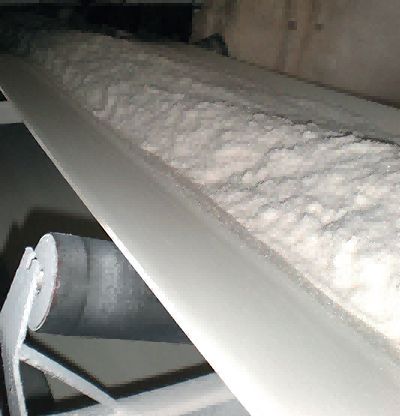Introduction
In the intricate web of processes that make up cigarette manufacturing, conveyor belts play a pivotal role in ensuring seamless operations. However, the use of Tobacco Industry Conveyor Belts for Cigarette Manufacturing introduces various safety considerations that must be meticulously addressed to safeguard both employees and the manufacturing environment. In this comprehensive guide, we delve into the essential safety measures that should be implemented when using conveyor belts in cigarette manufacturing facilities, emphasizing the paramount importance of prioritizing safety in every aspect of operations.

Employee Training and Education
The cornerstone of a robust safety culture within cigarette manufacturing facilities is comprehensive employee training and education. Employees working with Tobacco Industry Conveyor Belts for Cigarette Manufacturing must receive thorough training on proper operation, maintenance, and emergency procedures. This includes instructions on how to safely start, stop, and adjust conveyor belts, as well as protocols for handling emergencies such as jams or equipment malfunctions. Regular refresher courses should be conducted to reinforce safety protocols and ensure that employees remain vigilant and well-prepared to respond to any situation.
Equipment Safety Features
The installation of appropriate safety features on conveyor belt systems is imperative to prevent accidents and injuries. Safety guards and barriers should be installed to restrict access to conveyor belt areas and prevent unauthorized entry. Emergency stop buttons and pull cords should be strategically located along the length of the conveyor belt, enabling immediate shutdown in the event of an emergency. Regular inspection and maintenance of conveyor belt components, including pulleys, rollers, and bearings, are essential to ensure that safety features remain functional and effective.
Hazardous Material Handling Procedures
Cigarette manufacturing involves the handling of hazardous materials, including tobacco and tobacco products, which present unique safety challenges. Protocols should be established for the safe handling, storage, and disposal of these materials to minimize exposure and mitigate risks to employee health and safety. Proper ventilation systems should be installed to remove airborne contaminants and maintain air quality in conveyor belt areas. Additionally, employees working with or near Tobacco Industry Conveyor Belts for Cigarette Manufacturing should be provided with appropriate personal protective equipment (PPE), such as gloves, masks, and goggles, to minimize exposure to hazardous substances.
Housekeeping and Maintenance
Maintaining a clean and organized work environment is essential to prevent accidents and ensure the safe operation of conveyor belt systems. Regular cleaning and maintenance of conveyor belt components are necessary to prevent the buildup of debris or contaminants, which can cause equipment malfunctions or create safety hazards. Proper storage and disposal of materials, including flammable substances such as tobacco dust, are crucial to minimize fire hazards and safety risks. Scheduled maintenance checks should be conducted to identify and address wear and tear on conveyor belt components, reducing the risk of equipment failures and associated safety hazards.
Fire Prevention and Protection
Fire safety is of utmost importance in cigarette manufacturing facilities, where the presence of flammable materials poses a significant risk. Conveyor belt areas should be equipped with fire detection and suppression systems, such as smoke detectors, fire alarms, and automatic sprinkler systems, to detect and extinguish fires promptly. Employees should receive training on fire safety procedures and evacuation protocols to ensure a swift and organized response in the event of a fire emergency. Regular testing and maintenance of fire safety equipment are essential to ensure readiness and effectiveness in case of emergencies.
Compliance with Regulatory Standards
Compliance with industry-specific safety regulations and guidelines is non-negotiable when it comes to conveyor belt usage in cigarette manufacturing facilities. Regulatory authorities impose stringent requirements to protect employee health and safety, prevent environmental contamination, and ensure operational integrity. Facilities should undergo regular audits and inspections to assess compliance with safety standards and identify any areas for improvement. Collaboration with regulatory authorities is essential to address any safety concerns or updates to regulations promptly and effectively.
Continuous Improvement and Feedback
A commitment to continuous improvement is essential to maintain a culture of safety excellence within cigarette manufacturing facilities. Employees should be encouraged to provide feedback and suggestions for improving safety practices, and mechanisms should be in place to facilitate open communication and dialogue. Safety committees or task forces can be established to identify and address potential hazards, develop solutions, and implement safety improvements. Regular review and evaluation of safety protocols are necessary to incorporate lessons learned, industry best practices, and emerging technologies, ensuring that safety remains a top priority.
Conclusion
In conclusion, the safe and efficient operation of conveyor belts in cigarette manufacturing facilities requires a multi-faceted approach that encompasses employee training, equipment safety, hazardous material handling, housekeeping, fire prevention, regulatory compliance, and continuous improvement. By implementing comprehensive safety measures and fostering a culture of safety excellence, facilities can protect their employees, safeguard their operations, and ensure compliance with regulatory requirements. Ultimately, prioritizing safety is not only a moral imperative but also a sound business practice that contributes to the well-being of employees, the integrity of operations, and the sustainability of the industry as a whole.





